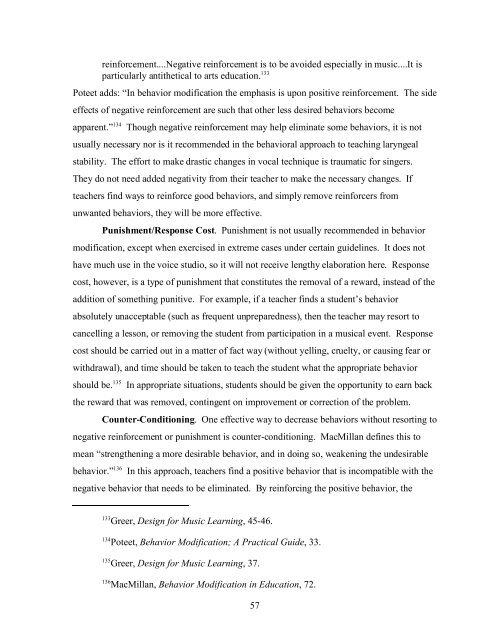THE FLORIDA STATE UNIVERSITY COLLEGE OF MUSIC THREE ...
THE FLORIDA STATE UNIVERSITY COLLEGE OF MUSIC THREE ...
THE FLORIDA STATE UNIVERSITY COLLEGE OF MUSIC THREE ...
You also want an ePaper? Increase the reach of your titles
YUMPU automatically turns print PDFs into web optimized ePapers that Google loves.
einforcement....Negative reinforcement is to be avoided especially in music....It is<br />
particularly antithetical to arts education. 133<br />
Poteet adds: “In behavior modification the emphasis is upon positive reinforcement. The side<br />
effects of negative reinforcement are such that other less desired behaviors become<br />
apparent.” 134<br />
Though negative reinforcement may help eliminate some behaviors, it is not<br />
usually necessary nor is it recommended in the behavioral approach to teaching laryngeal<br />
stability. The effort to make drastic changes in vocal technique is traumatic for singers.<br />
They do not need added negativity from their teacher to make the necessary changes. If<br />
teachers find ways to reinforce good behaviors, and simply remove reinforcers from<br />
unwanted behaviors, they will be more effective.<br />
Punishment/Response Cost. Punishment is not usually recommended in behavior<br />
modification, except when exercised in extreme cases under certain guidelines. It does not<br />
have much use in the voice studio, so it will not receive lengthy elaboration here. Response<br />
cost, however, is a type of punishment that constitutes the removal of a reward, instead of the<br />
addition of something punitive. For example, if a teacher finds a student’s behavior<br />
absolutely unacceptable (such as frequent unpreparedness), then the teacher may resort to<br />
cancelling a lesson, or removing the student from participation in a musical event. Response<br />
cost should be carried out in a matter of fact way (without yelling, cruelty, or causing fear or<br />
withdrawal), and time should be taken to teach the student what the appropriate behavior<br />
should be. 135<br />
In appropriate situations, students should be given the opportunity to earn back<br />
the reward that was removed, contingent on improvement or correction of the problem.<br />
Counter-Conditioning. One effective way to decrease behaviors without resorting to<br />
negative reinforcement or punishment is counter-conditioning. MacMillan defines this to<br />
mean “strengthening a more desirable behavior, and in doing so, weakening the undesirable<br />
behavior.” 136 In this approach, teachers find a positive behavior that is incompatible with the<br />
negative behavior that needs to be eliminated. By reinforcing the positive behavior, the<br />
133<br />
Greer, Design for Music Learning, 45-46.<br />
134<br />
Poteet, Behavior Modification; A Practical Guide, 33.<br />
135<br />
Greer, Design for Music Learning, 37.<br />
136<br />
MacMillan, Behavior Modification in Education, 72.<br />
57
















